Biology
 The fluid-mosaic model describes the plasma membrane that surrounds animal cell. The membrane has 2 layers of phospholipids (fats with phosphorous attached), which at body temperature are like vegetable oil (fluid).
The fluid-mosaic model describes the plasma membrane that surrounds animal cell. The membrane has 2 layers of phospholipids (fats with phosphorous attached), which at body temperature are like vegetable oil (fluid).
1. Fluid Mosaic Model
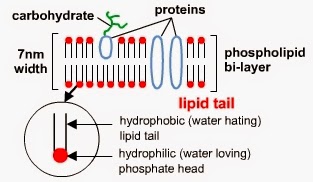
The role of the components of cell membrane
- Membrane Systems
Endoplasmic reticulum (ER) consists of a series of membranes creating channels within the cytoplasm, which are continuous with the nuclear membrane. They also form sheets that enclose cellular spaces called cisternae. ER provides a large surface area...
- Q: Explain How The Structure And Properties Of Triglycerides And Phospholipids Are Related To Their Functions In Living Organisms.
Triglycerides are a good source of energy as they have a high ratio of energy storing carbon-hydrogen bonds to carbon atoms. They are also an important source of metabolic water as the triglyceride molecules yield metabolic water on oxidation. This is...
- #27 Summary Of Cell Membrane
1 The basic structure of a membrane is a 7 nm thick phospholipid bilayer with protein molecules spanning the bilayer or within one or other layer. Phospholipids and some proteins move within the layers. Hence the structure is described as a fluid mosaic...
- # 25 Passive And Active Transport Across Cell Membranes
Substances can enter or leave a cell in 2 ways: 1) Passive a) Simple Diffusion b) Facilitated Diffusion c) Osmosis (water only) 2) Active a) Molecules b) Particles I. Passive transport across cell membranes 1. Diffusion Molecules and ions move...
- #23.1 Cell Membranes And Transport - Syllabus 2015
? Fluid mosaic model of membrane structure ? Movement of substances into and out of cells Learning Outcomes Candidates should be able to: (a) describe and explain the fluid mosaic model of membrane structure, including an outline of the roles of phospholipids,...
Biology
#24 Cell membranes - Fluid Mosaic Model of the plasma menbrane
 The fluid-mosaic model describes the plasma membrane that surrounds animal cell. The membrane has 2 layers of phospholipids (fats with phosphorous attached), which at body temperature are like vegetable oil (fluid).
The fluid-mosaic model describes the plasma membrane that surrounds animal cell. The membrane has 2 layers of phospholipids (fats with phosphorous attached), which at body temperature are like vegetable oil (fluid).1. Fluid Mosaic Model
- Because cells reside in a watery solution (extracellular fluid), and they contain a watery solution inside of them (cytoplasm), both layers of phospholipids (1) have the hydrophilic heads (2) facing outwards into the water and the hydrophobic tails (3) facing inwards, avoiding contact with water.
- Cholesterol molecules are among the phospholipids.
- Protein molecules (4) float in the phospholipid bilayer.
- Many of the phospholipids and proteins have short chains of carbohydrates (5) attached to them, on the outer surface of the membrane. They are known as glycolipids (6) and glycoproteins (7). There are also other types of glycolipid with no phosphate groups.
 |
| The fluid mosaic model of membrane structure. |
This is called the fluid mosaic model of membrane structure:
? 'fluid' because the membran is fluid (molecules within the membrane can move around within their own layers)
? 'mosaic' because the protein molecules are mosaiclly aranged
? 'model' because no-one has ever seen a membrane looking like the diagram - the molecules are too small to see even with the most powerful microscope.

The role of the components of cell membrane
Component | Roles |
Phospholipids |
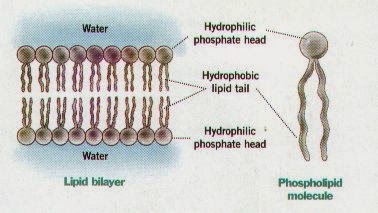 |
Cholesterol |
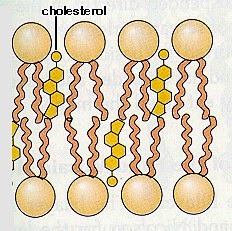 |
Proteins and glycoproteins |
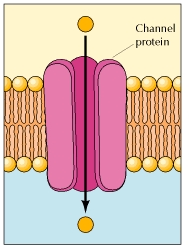

|
Glycolipids (Phosopholipid molecules + carbohydrates) |
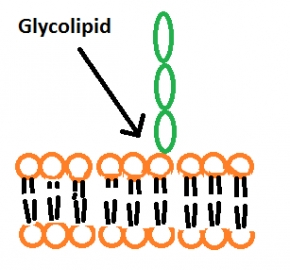 |
2. Roles of cell surface membranes
- Structural, keeping the cell contents together.
- Separate cell components from the outside environment
- Allows cells to communicate with each other by cell signalling.
- Allows recognition of other external substances.
- Allows mobility in some organisms, e.g. amoeba.
- Selectively permeable barrier.
- Regulating the transport of materials into or out of cells
- The site of various chemical reactions.
| Syllabus 2015 (a) describe and explain the fluid mosaic model of membrane structure, including an outline of the roles of phospholipids, cholesterol, glycolipids, proteins and glycoproteins; (b) outline the roles of cell surface membranes; |
Syllabus 2016 4.1 Fluid mosaic membranes The structure of cell surface membranes allows movement of substances between cells and their surroundings and allows cells to communicate with each other by cell signalling. a) describe and explain the fluid mosaic model of membrane structure, including an outline of the roles of phospholipids, cholesterol, glycolipids, proteins and glycoproteins b) outline the roles of cell surface membranes including references to carrier proteins, channel proteins, cell surface receptors and cell surface antigens c) outline the process of cell signalling involving the release of chemicals that combine with cell surface receptors on target cells, leading to specific responses |
- Membrane Systems
Endoplasmic reticulum (ER) consists of a series of membranes creating channels within the cytoplasm, which are continuous with the nuclear membrane. They also form sheets that enclose cellular spaces called cisternae. ER provides a large surface area...
- Q: Explain How The Structure And Properties Of Triglycerides And Phospholipids Are Related To Their Functions In Living Organisms.
Triglycerides are a good source of energy as they have a high ratio of energy storing carbon-hydrogen bonds to carbon atoms. They are also an important source of metabolic water as the triglyceride molecules yield metabolic water on oxidation. This is...
- #27 Summary Of Cell Membrane
1 The basic structure of a membrane is a 7 nm thick phospholipid bilayer with protein molecules spanning the bilayer or within one or other layer. Phospholipids and some proteins move within the layers. Hence the structure is described as a fluid mosaic...
- # 25 Passive And Active Transport Across Cell Membranes
Substances can enter or leave a cell in 2 ways: 1) Passive a) Simple Diffusion b) Facilitated Diffusion c) Osmosis (water only) 2) Active a) Molecules b) Particles I. Passive transport across cell membranes 1. Diffusion Molecules and ions move...
- #23.1 Cell Membranes And Transport - Syllabus 2015
? Fluid mosaic model of membrane structure ? Movement of substances into and out of cells Learning Outcomes Candidates should be able to: (a) describe and explain the fluid mosaic model of membrane structure, including an outline of the roles of phospholipids,...
